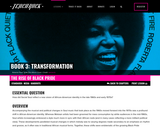
Accompanying the musical and political changes in Soul music that took place as the 1960s moved forward into the 1970s was a profound shift in African-American identity. Whereas Motown artists had been groomed for mass consumption by white audiences in the mid-1960s, Soul artists increasingly embraced a style much more in sync with their African roots (and in many cases reflecting a more militant political view). These developments paralleled musical changes in which melody was to varying degrees made secondary to an emphasis on rhythm and groove, as it often was in traditional African musical forms. Together, these shifts were emblematic of the growing Black Pride movement, with its characteristic slogan, "black is beautiful." This lesson looks at these social and musical changes, with a focus on James Brown and his seminal proclamation of black pride, "Say It Loud, I'm Black and I'm Proud."
- Subject:
- Arts and Humanities
- Performing Arts
- Material Type:
- Full Course
- Provider:
- TeachRock
- Date Added:
- 12/13/2019


